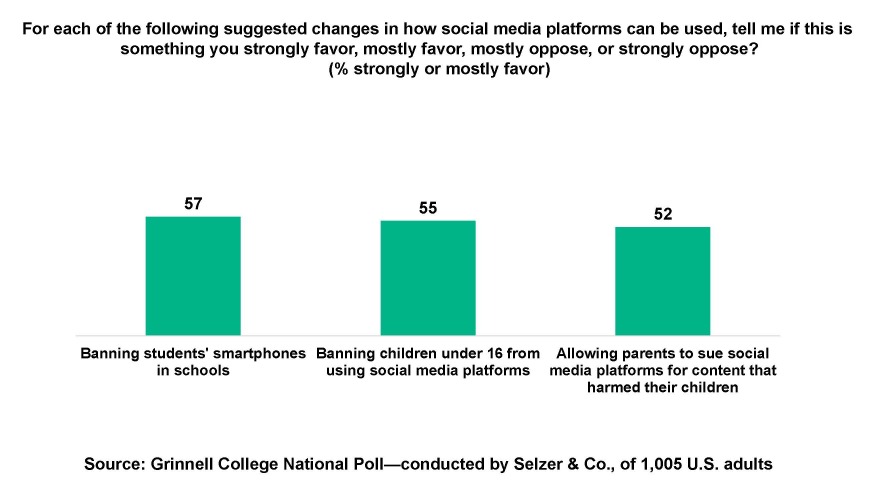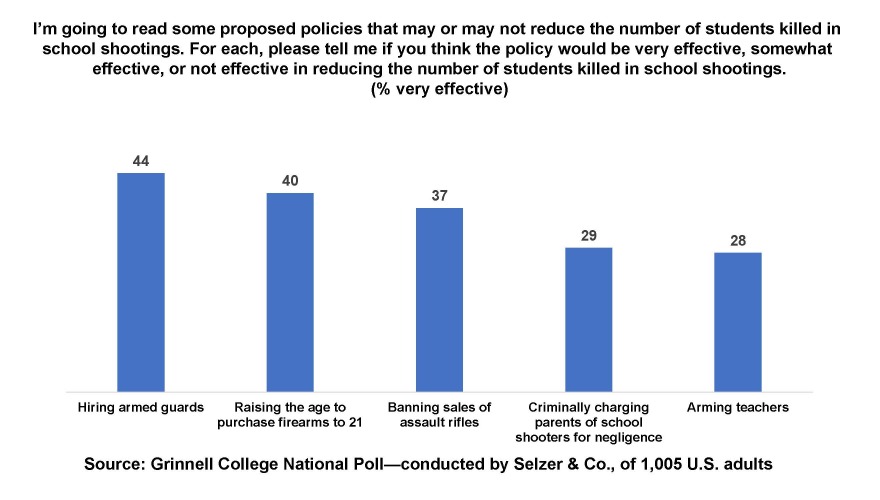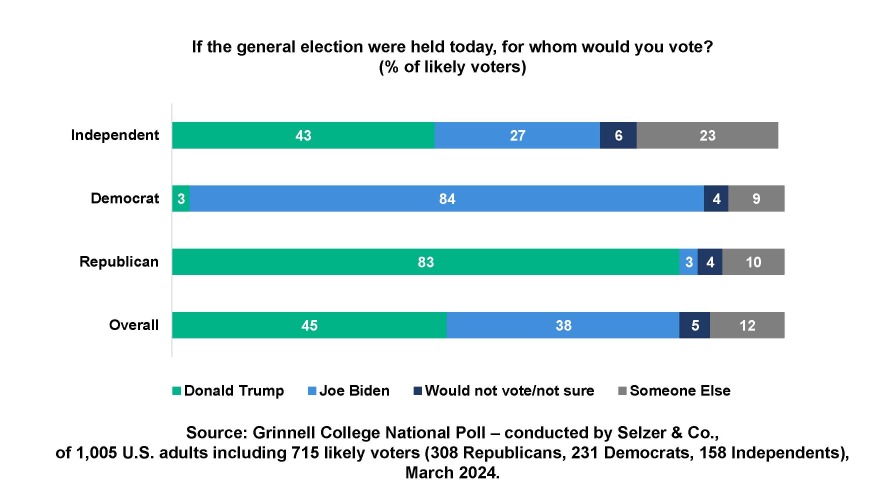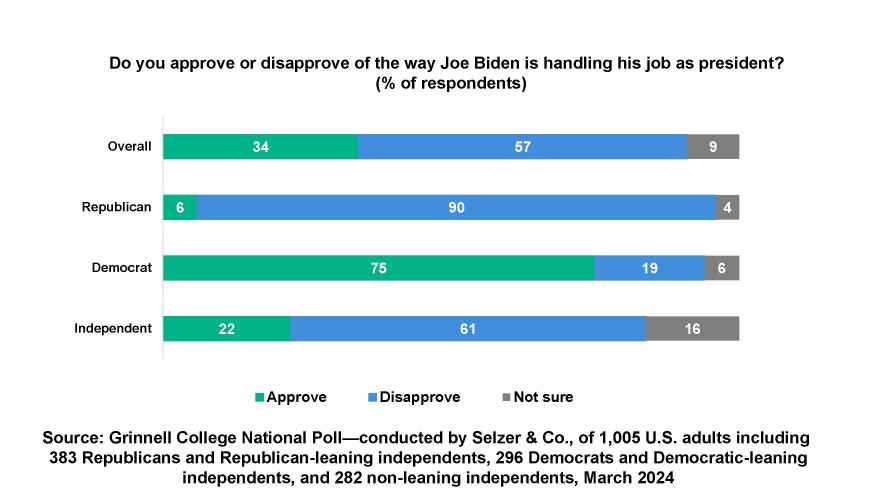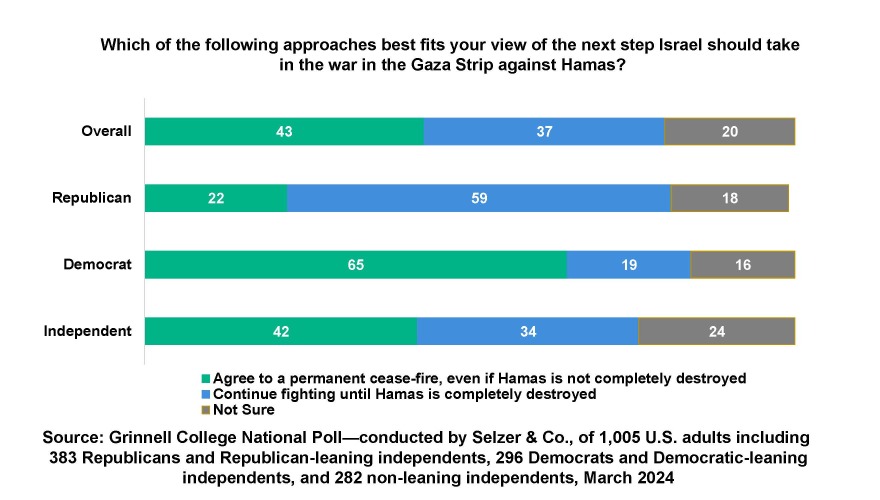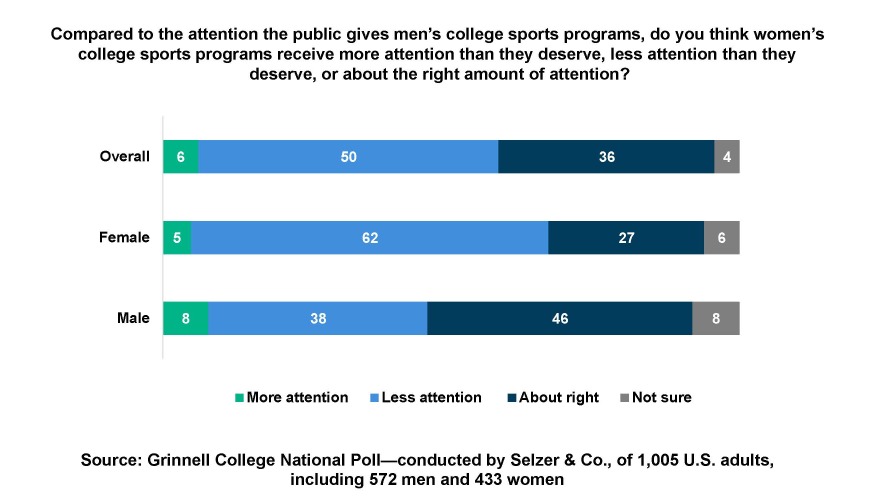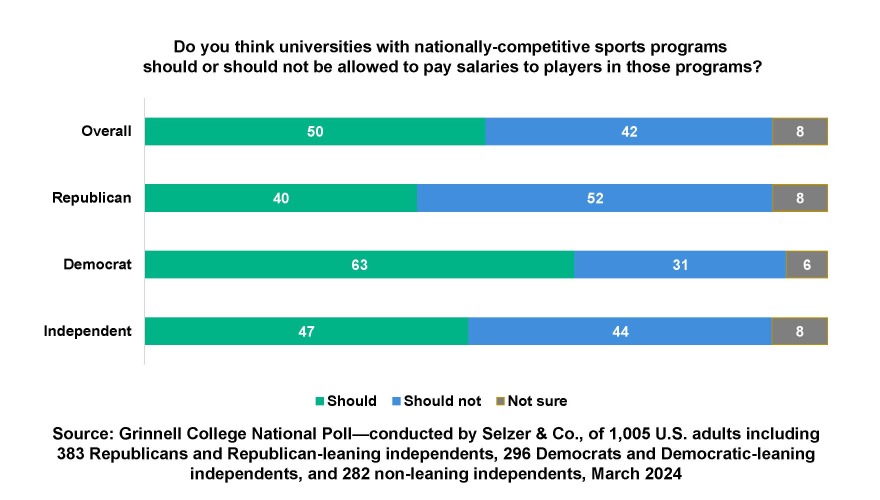Grinnell College National Poll: Consensus on Protecting Kids from Social Media, But Not School Shootings
Wide-ranging survey reveals Americans’ Division on Biden’s Job Performance and Trump’s Candidacy, a Cease-Fire in Gaza, College Sports and More
The latest Grinnell College National Poll finds broad support for protecting children from the potential harms of social media, but no consensus on the best ways to protect them from mass shootings at school. The poll of 1,005 U.S. adults conducted by Selzer & Company March 11–17, 2024, found that 55% of Americans favor banning children under 16 from using social media platforms, with the proportion rising to 65% among those with children under 18 years old at home. More than half (52%) favor allowing parents to sue social media platforms for content that harmed their children, and 57% favor banning students’ smartphones in schools.
Karla Erickson, professor of sociology at Grinnell College, says that so-called “techlash” against the power of social media platforms has been a topic of conversation among sociologists, but researchers have seen few people willing to change their individual behaviors.
“It’s striking that there is majority support for all three of these proposals, and this helps to explain why legislation to ban TikTok passed the House of Representatives so easily. Bipartisan support for suing tech companies for harm to kids is especially notable, given that Democrats and Republicans usually feel differently about corporate responsibility,” says Erickson.
“It is especially surprising that more than half of Americans support banning smartphones from schools – a measure that would inconvenience many parents on a daily basis. What isn’t surprising is that these measures are much less favored by Americans under 35, most of whom grew up with smartphones.”
By contrast, the poll found no consensus on policies aimed at reducing the number of students killed in school shootings.
Respondents were asked if any of five proposed policies would be effective in reducing the number of students killed in school shootings: hiring armed guards, arming teachers, raising the age to purchase firearms to 21, banning assault rifles or criminally charging parents of school shooters for negligence. None of the policies was rated by a majority of respondents as likely to be “very effective” in reducing the number of student deaths.
“As a society, we can’t reach agreement on what we should do to keep our kids safe from mass shootings in schools. Democrats are skeptical that arming school staff will protect kids, and Republicans don’t think that restricting firearms will make a difference,” said Peter Hanson, poll director and associate professor of political science at Grinnell College. “If any issue should unite Americans, it is protecting kids from gun violence in schools, but the politics of gun safety continue to be extraordinarily difficult to resolve.”
Sixty percent of Republican and Republican-leaning independent voters vs. 29% of Democrats and Democratic-leaning independent voters think hiring armed guards would be very effective. That sentiment is reversed when considering the effectiveness of banning sales of assault rifles (with 65% of Democrats vs. 16% of Republicans saying it would be very effective).
Biden Trails Trump and Loses Ground in Key Demographics
President Joe Biden is trailing former President Donald Trump in the race for president, with Biden’s job approval and favorability ratings falling to the lowest levels measured by the poll while Trump’s ratings have improved.
If the race were held today, Trump would be the favorite of 45% of likely voters, in contrast to just 38% saying they would vote for Biden. Trump leads among likely voters who identify as independent, with 43% for Trump and 27% for Biden – but 23% of this group say they would vote for someone else.
“Our snapshot of the national electorate shows President Biden in deep trouble. Compared to our polling last fall, Donald Trump’s position has grown stronger, while Joe Biden’s has deteriorated,” said Hanson. “Meanwhile, Democrats have lost the enthusiasm advantage they held prior to the 2020 election, when 88% of Democrats said they would definitely vote. That number has fallen to 76%, giving Republicans a narrow edge in the pool of likely voters.”
The poll shows a significant gender gap in the choice for president. Trump wins with men by almost a two to one margin, with 55% of men behind his candidacy compared to 30% for Biden. Women favor Biden by a 10 percentage-point margin (45-35%).
Only 34% of Americans approve of President Biden’s job performance and a new high majority of 57% disapprove of how he is doing his job.
“Even among Democrats and Democratic-leaning respondents, about one in five disapprove of Biden’s performance,” said J. Ann Selzer, president of the Des Moines, Iowa-based polling firm Selzer & Company. “We are also seeing weakness among suburban women, who were partly responsible for his victory in key swing states in 2020. As recently as October 2023, Biden’s approval rating among suburban women was 53%, with just 37% disapproving of his job performance. Now, in March, he’s underwater with just 44% of suburban women approving and a striking 46% disapproving of his performance,” said Selzer.
When asked about favorability more broadly, majorities of Americans view each candidate unfavorably. But Trump’s numbers have improved from previous lows, increasing from 38% favorable a year ago to 46% today. Meanwhile, Biden’s have declined, falling from 44% favorable a year ago to 37% today.
“That's the 2024 race in a nutshell: voters will likely have to choose between two candidates who are viewed unfavorably by a majority of Americans,” said Hanson. “It’s a tough spot for the average voter to be in.”
About one in ten likely voters are unfavorable toward both Biden and Trump. “They tilt toward Biden (17% vs. 14% for Trump), but a full 60% indicate that they will vote for someone else,” says Selzer. “Among the general population respondents who view both candidates negatively, 39% have a very unfavorable view of Biden and 48% of Trump. Just over half (53%) are likely to vote vs. 70% of respondents overall.”
Biden’s Support Among Democrats May Hinge on Israel
With the war between Israel and Hamas continuing, more U.S. residents say Israel should agree to a permanent cease-fire, even if Hamas is not “completely destroyed” (43%) than say Israel should continue fighting until Hamas is “completely destroyed” (37%). There is a large partisan divide in these findings, with 65% of Democrats favoring a permanent cease-fire and 59% of Republicans preferring Israel to continue fighting.
Americans are also divided in their view of Israeli Prime Minister Benjamin Netanyahu, with 31% viewing him favorably, 34% unfavorably, and those who do not know enough to say making up 36%. The partisan divide is dramatic, with 53% of Republicans having favorable views of Netanyahu compared to 57% of Democrats having unfavorable views.
“Democratic opposition to the war in Gaza has added to the political challenges facing President Biden,” said Hanson. “He has staked out a position in support of Israel that can’t easily be squared with the strong desire of Democratic voters for a ceasefire, and that’s going to complicate his effort to mobilize Democrats to vote in November.”
March Madness: Gender and Partisan Views of College Sports
The NCAA Women’s basketball tournament is currently being covered by sports media across the nation, but half of Americans (50%) still say women’s college programs get less attention than they deserve, compared to men’s college sports. Women are much more likely to say this (62%) than are men (38%), with the plurality of men (46%) saying the amount of attention is about right. Almost three in four (70%) Democrats say women’s sports programs get less attention than they deserve, as do a plurality of independents (43%); it’s 41% among Republicans and 62% of suburban women.
“Being in Iowa, it’s really exciting to see how breakout stars like the University of Iowa’s Caitlin Clark are generating excitement for women’s college basketball. Viewership has gone up and is setting records across all sorts of media outlets,” says Kirsten Koester, associate professor of physical education at Grinnell College, where she also serves as head women’s soccer coach and senior woman administrator. “Yet the reality is that women’s sports still represent a fraction of all sports coverage. There’s a huge portion of women’s athletics that don’t get much attention.”
In the midst of an ongoing national discussion about how to fairly compensate student athletes, half (50%) of Americans say that colleges and universities with nationally competitive sports programs should be able to pay salaries to college athletes, while 42% disagree. The idea of paying players is embraced by 63% of Democrats and just 40% of Republicans.
Koester said that proposals to pay student-athletes raise challenging questions about how to maintain fairness and equity, including balancing the needs of large and small schools, maintaining equity across men’s and women’s sports programs, and treating players on the same team fairly.
“There’s an ongoing conversation in college sports right now about Name, Image, and Likeness (NIL), which is one way that college athletes can get paid. But NIL only works for student-athletes with name recognition, and it takes everyone on a team to win – those other athletes are working just as hard as the top names. This is a timely conversation, but not a new one,” she said.
“There’s also the possibility that paying student-athletes in national revenue-earning sports like football and men’s basketball would create huge equity issues between men’s and women’s sports, and disadvantage sports like swimming and track and field that don’t earn a profit.”
The Grinnell College National Poll surveyed 1,005 Americans ages 18 and over between March 11–17, 2023. The sample is weighted by sex, age, and race. Results for questions asked of the full sample have a margin of error of +/- 3.1 percentage points.

